Search results for 'omer'
-

COM 330 Chapter 12 Assignment
$20.00COM 330 Chapter 12 Assignment
1. The following data structure and constraints exist for a magazine publishing company.
Learn More
a) The company publishes one regional magazine in each region: Florida (FL), South Carolina (SC), Georgia (GA), and Tennessee (TN).
b) The company has 300,000 customers (subscribers) distributed throughout the four states listed in Part a.
c) On the first of each month, an annual subscription INVOICE is printed and sent to each customer whose subscription is due for renewal. The INVOICE entity contains a REGION attribute to indicate the state (FL, SC, GA, TN) in which the customer resides:
CUSTOMER (CUS_NUM, CUS_NAME, CUS_ADDRESS, CUS_CITY, CUS_ZIP, CUS_SUBSDATE)
INVOICE (INV_NUM, INV_REGION, CUS_NUM, INV_DATE, INV_TOTAL)
The company’s management is aware of the problems associated with centralized management and has decided to decentralize management of the subscriptions into the company’s four regional subsidiaries. Each subscription site will handle its own customer and invoice data. The management at company headquarters, however, will have access to customer and invoice data to generate annual reports and to issue ad hoc queries such as:
• List all customers by region.
• List all new customers by region.
• Report all invoices by customer and by region.
Given those requirements, how must you partition the database?
2. Given the scenario and the requirements in Question 2, answer the following questions:
a. What recommendations will you make regarding the type and charistics of the required database system?
b. What type of data fragmentation is needed for each table?
c. What criteria must be used to partition each database?
d. Design the database fragments. Show an example with node names, location, fragment names, attribute names, and demonstration data.
e. What type of distributed database operation must be supported at each remote site?
f. What type of distributed database operations must be supported at the headquarters site? -
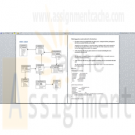
Home Warranty Corporation HWC ERD and SQL script
$20.00Case Scenario Home Warranty Corporation ERD and SQL scriptHome Warranty Corporation (HWC) provides warranties for home appliances. Home owner’s purchase these warranties as insurance policies on their various appliances (washers, driers, dishwashers, etc.). They pay HWC an annual fee for each appliance that they want covered and HWC is responsible for any necessary repairs. A contract is signed for a particular residence. The contract includes a list of the appliances covered for that residence. While most customers have only one contract, some have multiple contracts if they have multiple residences. HWC maintains a warehouse with parts that are necessary for repairs. In addition, they employ hourly service personnel who service the appliances when a problem arises. HWC needs a database to maintain information about their customers, contracts, appliances under contract, parts in the warehouse, employees, and service calls (including costs).
The customer information would include the name of the customer, their phone# and address information for billing purposes. Each customer may have one or more contracts. The contract information includes address information for that particular contract as well as the appliances under contract at that address. In addition, the start and end dates of the contract should be maintained. The appliance information includes the manufacturer, the manufacturer serial# and a description of the appliance as well as the annual fee the customer is paying for the warranty on the appliance. Fees for a particular appliance may differ between contracts as HWC changes fees periodically and may offer some customers lower fees based on volume. The part information would include the part#, description, part cost, and quantity on hand. The employee information would include the name and hourly cost of each employee. The service call information would include the date of the service call, the contract being serviced, the appliance being serviced, the employee(s) who completed the service and the costs associated with the call. Those costs would include the cost of the part(s) used and # of hours spent on the call by each of the service people. Each service call may have one or more service people and may require one or more parts. A separate call is recorded for each appliance serviced.
Some of the goals that HWC wants to accomplish with their database include:
- If a given contract is profitable for any given year. (compare the fees paid against the costs associated with the service calls)
- A list of service calls for any given contract or customer including the costs associated with each call.
- A list of service calls for any given appliance including the costs associated with each call.
You are required to use any available to tool to design and develop an ER diagram and write SQL script. The accepted file formats are MS Word or PDF file format.
Learn More -
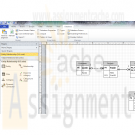
Small Advertising Company ERD
$15.00The purpose of this assignment is to allow you to practice designing and developing an ER diagram by using an appropriate tool.
This assignment requires you to develop an ER Diagram for a database that is used to maintain basic information concerning the hours spent on projects by employees in a small advertising company. A customer may have many projects and an employee may have worked on many projects. Each project is for just one customer.
The tables needs to include the following:
• Customer(id, name).
• Employee(id, name, department id, salary).
• Project(id, title, customer id).
• EmpProj(employee id, project id, hours).Primary keys and foreign keys need to be identified as well. Draw the ER Diagram using any tool that you want. The easiest is probably a word processor, but you could also use a drawing tool such as Visio.
Learn More -
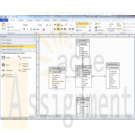
Coffee Merchant Enterprises (CM) and Home Warranty Corporation (HWC) Data Warehouse OLAP database
$20.00Coffee Merchant Enterprises (CM) and Home Warranty Corporation (HWC) Data Warehouse OLAP database
The purpose of this assignment is to promote students analytical skills in analyzing a case scenario and utilizing the given information and resources to design an ER diagram and develop an OLAP database.
1. Case Scenario
Coffee Merchant Enterprises (CM) sells coffee from a variety of different countries to consumers in the US. Their sales are all on-line. Their OLTP database for handling their day-to-day operations is shown in the ER Diagram below:CM wants to make data more available to their marketing analysts so that they can develop more effective marketing programs. They want to accomplish this goal without slowing down the performance of their existing OLTP system. They have decided to create a Data Warehouse to provide the information that the marketing analysts need. Your task is to design the database for the Data Warehouse.
The marketing analysts have asked for the ability to see sales data by product (inventory), consumer, employee who placed the order, and by various date variables including date, week, quarter, year, day of the week, and season. They do not need to see every sales but would need to see product sales summarized for each product on a daily basis.
2. Case Scenario
Consider the following ER Diagram for the OLTP database you designed from Home Warranty Corporation in the Case Project for Module 11. Your design may have differed from the one below, but this is the design that HWC decided to use.HWC has decided to develop a Data Warehouse so that they can analyze costs to assist in making a number of business decisions. For example, they want to determine if certain customers are costing more because they may be too hard on their appliances or if certain appliances that they cover tend to break down more than others, thus incurring more cost. Your task is to design the database for the Data Warehouse. The business managers have asked for the ability to see costs by customer, appliance, employee, and by various date variables including date, week, quarter, year, day of the week, and season. The need to see this cost information for every Service Call and need know the labor cost, material cost, and sum of both.
Learn More -
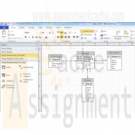
OLAP Database and ERD
$15.00This assignment requires you to develop an ER Diagram and design OLTP database that shows all tables (and attributes) and relationships based on the giving information and ER Diagram.
Learn More
Steps:
Step 1: Please consider the ER Diagram for an OLTP database below:
Step 2: Develop an OLAP database design based on the following information:
Fact: Quantity and Price of each item sold
Granularity: All sales
Dimensions: Products, Customers, Dates
Step 3: Develop the ER Diagram that shows all tables (and attributes) and relationships. -
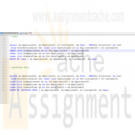
Home Warrany Corporation HWC CUBE and GROUPING SETS SQL Statements
$15.00You designed an OLAP database for Home Warrany Corporation. Based on that design, submit the following two SQL statements.
1. Use the CUBE extension to show the sum of costs aggregated by all permutations of appliance serial, employee id, customer id, and year.
Learn More
2. Use the GROUPING SETS extension to show the same data. -
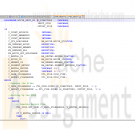
DBM 405 Lab 6 Reading and Writing to External Files
$20.00DBM 405 Lab 6 Reading and Writing to External Files
Learn More
Scenario/Summary
This week, we are going to make a change to the processing in our schema by altering one of the procedures contained in the package previously created. At this point, we have dealt with procedures that required us to pass parameter values each time the procedure was executed. This type of processing greatly limits the ability to process large amounts of data efficiently. The lab this week will introduce you to a couple of the procedures contained in the UTL_FILE package that is part of Oracle's group of built-in packages. By using the GET_LINE and PUT_LINE procedures contained in UTL_FILE, you will be able to process multiple records from a file and create a results report on the events performed by your movie rental procedure with one call to execute the procedure.
For the lab, you will need to create a script file containing the PL/SQL code that will address the lab steps below. Run the script file in your SQL*Plus session using the SET ECHO ON session command at the beginning to capture both the PL/SQL block code and output from Oracle after the block of code has executed. You will only need to recompile both the package specifications and the package body since you will be making a change to the movie_rental_sp procedure in the specifications. You will be running tests to verify that the changes to your procedure are working as they should. Spool your output and name your files with your last name plus lab 6 and give the file a text (txt) extension. For example, if your last name was Johnson then the file would be named johnson_lab6.txt. Submit both the spooled output files AND the script file for grading of the lab.
IMPORTANT: Before beginning the lab, you will want to refresh the tables in your schema by running the movierental.sql script.
LAB STEP
Step 1: Setting Up Your Environment
Before you can effectively use the procedures in UTL_FILE to work with external files for this lab, you will need to set up your environment. The first step of this process will involve creating a directory folder under the R: drive which is the mapped drive for DBM405. The second part of the process will involve creating the Directory Object in Oracle to point to this folder. To accomplish this task, please follow the steps listed here.
1. Create the directory folder (You can refer to the SQL*Plus Tutorial in Week 1 for visuals of this process).
• First, log into the iLab and open up your Oracle folder. Next, open Windows Explorer and expand the R: drive tree.
• Under the R: drive, create your own folder by selecting File/New/Folder from the main menu bar. Name your folder using a unique name such as DBM405_lastname_lab6 or some other unique name. Make sure that there are no other folders under the R: drive with the same name as yours. You are the only person who has access to your folder, but the name must be unique.
2. Create the Directory Object.
• In Windows Explorer (the one in the Oracle folder in the iLab), you want to take note of the path name for the R: drive. It will be DBM405\ followed by the session you are in. For example, if you are in Spring A, the path would be DBM405\SPRINGA, or if Spring B, it would be DBM405\SPRINGB. This is important because this will be used to define the path for the Directory Object. Remember that the R: drive is really mapped to the Oracle server F: drive.
• Start up a session in SQL*Plus and log into your user schema.
• Use the following SQL command to create the Directory Object that you will use for this lab.
Create or Replace Directory DBM405_YOURNAME_DIR As 'F:\DBM405\session\YourFolderName';
IMPORTANT: Replace the word YOURNAME with your actual last name, the word session with the session name found in the path for the R: drive (see first bullet above), and the word YourFolderName with the name of the folder you created in Part 1 above. For example, if your last name were SMITH and you were taking this course is Spring session A and the folder you create was named DBM405_SMITH_lab6, the statement would be:
Create or Replace Directory DBM405_SMITH_DIR As 'F:\DBM405\SPRINGA\DBM405_SMITH_LAB6';
3. Set up the data file.
• Download the file "movierentaldata.txt" from Doc Sharing and place this file in the directory folder you created above in Part 1.
You have now set up Oracle to work with the procedures in UTL_FILE that we will use for this lab.
Step 2: Changing the Package Specifications
We are now ready to start updating the package that we modified in Lab 5 so that it will allow us to read a file and make changes to the database. To do this, we will need to make changes to the parameter list of the MOVIE_RENT_SP procedure to reflect a new process. Since we will be changing the parameter list, we will need to make changes to the Package Specifications as well as to the Package Body.
For the change to the Package Specifications, you will need to define a parameter for the Directory Object, one for the input file, and one for an output file that will be used for a verifications report. Each of these parameters can be defined as VARCHAR2 data types.
Step 3: The DECLARE (IS) Section of the Procedure
Now, we can move on to the Package Body and the MOVIE_RENT_SP procedure itself. The first thing you want to do is make sure that the parameter list in the procedure matches the parameter list that you just changed in the Specifications in Step 2. The two parameter lists must match exactly or you will get errors when trying to compile the Package Body.
When you read in the file, you will need several variables to handle both the record and the various pieces of data in the record. When the record is read in, you will need to substring each piece of data from the record into a variable which then can be used like you were using the parameters before. To keep from having to make numerous changes in the code, you might want to consider using the actual parameter names from your parameter list in the code from Lab 5. For example, if the parameter name for the movie ID was P_MOVIE_ID then you would create a variable named P_MOVIE_ID. Each of the variables for movie ID, member ID, and payment method can be cast to the data type in the MM_RENTAL table. For example:
p_movie_id mm_rental.movie_id%TYPE;
You will also need a variable to hold the record data that will be read in and a variable to hold record data that will be written out. Check the length of the data in the movierentaldata.txt file to determine the length for the input data variable. For the output data variable, you can use your own judgment, but using VARCHAR2(80) would probably be more than adequate.
The last thing you will need to add is a variable to act as the handle for the input record and one for the output record. Remember that the name for these is not important, but they must be based on the FILE_TYPE data type.
Step 4: Opening the Files
Now, we move to the body of the code and the BEGIN section. The first thing that needs to happen is to open both the files. Remember that we are going to set up our processing just like we would any IPO logic, i.e., we need to open the files, read a record, process the data, read the next record, and repeat this process until there is no more data.
To accomplish this first step of opening the files, you will need to initialize the two variables you declare to handle the files. For the input file, you will need to use the FOPEN program. Remember that you have to pass this program three variables: the name of the parameter for the directory object, the name of the parameter for the input file, and the mode the file is to be in. For the input file, the mode needs to be "r", and for the output file, the mode needs to be "w".
An example of what your code might look like can be found in the lecture material for this week.
Step 5: Setting Up the LOOP
Since our code in its current format is designed for only one set of input values (remember that in previous labs we were using an EXECUTE command and then passing data to the procedure) and we now want to process multiple records of data, we need to make a change to the overall structure of the code. We need to put all of the processing in the body of the procedure after the files are opened into a basic LOOP using the LOOP/END LOOP commands. Also, we will need a new BEGIN section inside this LOOP that all of the existing code will go into. The basic structure of body of your code should look like the following when you complete this step.
BEGIN
open files
LOOP
BEGIN
file processing
BEGIN
existing process to increment rental_id
EXCEPTION
END
EXCEPTION
END
END LOOP
END
Step 6: Setting Up the File Read and Process
Now, we need to get our data record so that we can process the data brought into the program. To do this, we need to read a record using the GET_LINE program in UTL_FILE. This involves using the UTL_FILE.GET_LINE process while passing the file handle variable and input record variable to the GET_LINE program.
Once the record is in the input variable, we then need to parse out the individual pieces of data (movie ID, customer ID, and payment method) from the record using the SUBSTR function. Remember that the parameters for the SUBSTR function are the record variable name, the value for the first byte of data we want to pull, and the length of the data. For example, to get the movie ID from our record, the code might look like the following.
p_movie_id := SUBSTR(v_rental_record, 1, 2);
This would pull two bytes of data from the data record and put them in the variable p_movie_id. Now we can use the variable in our code that follows to see if that movie ID exists in the mm_rental table. You will need to repeat the process above for the member ID and the payment method. Do all three together between the line of code that reads the file and the first SELECT statement.
Step 7: Setting Up the Output Process
If you have used the same names for your three data variables that you used for the original parameter names in the previous lab then you should not have to make any changes at all to any of the SELECT statements or the INSERT statement in the main body of code. Now, we need to set up the processing that will create the output data that will go into our output validation record. To do this, you will be using the PUT_LINE program within UTL_FILE.
There are going to be six different places you will want to write out a record. The first will be after the insert statement when a new rental record is added to the mm_rental table. To create this output line you can concatenate variables and character strings together to create the data record. For example, to create an output line that would read "Rental record 13 for member 10 has been added" after the new record has been inserted, you would use code similar to the following (keep in mind that your variable names might be different).
v_report_record := 'Rental record '||v_rental_id||' for member '||p_member_id||
' has been added';
UTL_FILE.PUT_LINE(v_report_filehandle, v_report_record);
This same type of process and format will need to be repeated for each exception handler that in the previous lab used the DBMS_OUTPUT.PUT_LINE package and procedure. In these cases, your output line is already formatted and set, you just need to replace the DBMS_OUTPUT.PUT_LINE with the initialization of your output record and then add the UTL_FILE.PUT_LINE code.
Step 8: Getting Out of the LOOP and Closing the Output File
There is one final step that has to be taken care of before you can start testing your code. Since we are reading a record file within a LOOP we need to be able to EXIT out of the loop after the last record has been processed. To do this you will need to add a NO_DATA_FOUND exception to your main exception handling section. This exception handle must be added before the WHEN OTHERS exception handle (remember, that on has to be last). This exception handle will have three pieces to process.
The first will be some form of message stating that all the records have been processed and this is the end of the report, i.e., ALL RECORDS PROCESSED - END OF REPORT. The second piece will be a line that will close the output file using UTL_FILE.FCLOSE. The only parameter you will need to pass is the name of the output file variable. This must be done or your output file will not have any data in it. The third thing will be the word EXIT which will tell the program to exit out of the loop.
You are now ready to compile your package specifications (must be done first) and then the package body. Debug any errors you might have and then run your test.
Step 9: Testing Your New Procedure
For this lab, you only need to test the MOVIE_RENT_SP procedure of the package. To do this, enter an EXECUTE command for the package.procedure and pass the name of your Directory Object, input file name, and output file name to the procedure. IMPORTANT: The Directory Object name MUST BE IN UPPERCASE! This is the way it is stored in the data dictionary in Oracle and if it is not in uppercase, an error will be generated. Your call to the new procedure should look similar to the following.
execute MM_RENTALS_PKG.movie_rent_sp('DBM405_SMITH_DIR','movierentaldata.txt','rentalreport.txt');
The output in your output file should look similar to the following (the wording may be different but the processes recorded should be the same).
There is no movie with id 13. Cannot proceed with rental.
There is no member with id 20. Cannot proceed with rental.
There is no payment method with id 7. Cannot proceed with rental.
Rental record 13 for member 10 has been added.
Movie id 5 is not available at this time. Cannot proceed with rental.
This concludes the Lab for Week 6. -
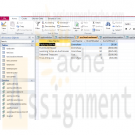
Succeeding in Business with Access Chapter 3 Case Problem 1 and 3
$25.00Succeeding in Business with Access 2010
Learn More
Chapter 3 Analyzing Data for Effective Decision Making
Case Problem Level 1 - managing Customer Information for NHD Development Group Inc.
Antiques.accdb complete solution from Step 1 - Step 12.
Case Problem Level 2 - Retrieving Employee Information for MovinOn Inc.
MovinOn.accdb complete solution from Step 1 - Step 12. -
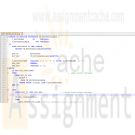
CMIS 420 Project 2 Advanced Relational Database Concepts and Applications
$20.00CMIS 420 Project 2 Advanced Relational Database Concepts and Applications
Learn More
1. Description:
Demonstrate your knowledge of PL/SQL programming by writing and thoroughly testing triggers and stored procedures associated with an e-commerce application that provides security logs for all transactions by user, product, and date. I will provide specific requirements and design details for this project below and we could have more discussion about the project in the Conferences area. Submit the scripts with all of your function SQL and PL/SQL code, and provide the results of running your scripts with the SQL*Plus spool command.
2. Functional requirement:
We will develop a small online transaction application supported by our database, movie distributing and renting system. In the application, we should meet three functional requirements:
1) Track transaction events, and track runtime errors.
2) Handle either movie distributing business process.
3) Application interface which allows users to process either orders.
4) No additional database tables are required unless you think it is necessary to enhance your application.
3. Track transaction events, and track runtime errors:
The link below provides a script which allow you to create two tables for tracking purposes One table for tracking events and the other for errors.
Script to create logs tables
Track errors or exceptions during runtime.
Track any error or exception occurs during your application execution. this means that you should include tracking code in every program unit you develop.
Take a look of the table for error logging and see what data should be inserted into the table when error occurs. The code should be part of error handling in exception handle section.
Track event or application process during runtime.
This type of logs for recording the events during the code execution. Content of the log may contain part of the data being changed and who changed it. The code to track events should be located at the end of a process.
Take a look of the table for event logging and see what data should be inserted into these tables after event occurs.
4. Handle movie distributing business process.
In this part of the project, you are asked to design a few stored procedure or functions to handle online movie distribution.
These procedures or functions should be able to
1)process orders for distributors. When a customer (movie store) places order, ordering information should be stored in database tables.
2)allow customers (movie stores) to check movie availability. if it is available, provide number in stock and unit price. If unavailable message the customer the movie requested is not available.
3) if the order has been filled, generate an invoice to send to the customer.
Note: This is one of the place where tracking event is necessary.
Errors and events should be both tracked as described before.
5. Application interface which allows users to process either orders:
In general, the interface should provide GUI to users. However, PL/SQL does not have that feature. What we are going to do is to develop script which performs the similar functionality.
Script should be able to
1) take an order (ordering data)
2) place an order by calling all the procedures used to process order.
3) generate and print invoice based on order id.
4) query event_logs and error_logs to show the result of the order transaction and/or any potential issues within the order.
6. Submit requirement:
The scripts to create procedures and function.
The script to execute the procedures to place orders
The text file for output of execution results. -
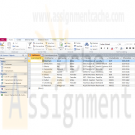
Small Business Jewelry Store Access Database with Form and Reports
$20.00Create a database using Microsoft Access.
Learn More
The database should contain three tables: Customers, Products, and Transactions; three queries: list of customers, transactions by customer, and transactions by product; and be something that a small business, such as a jewelry store or used car lot, can use for its daily needs.
The database must contain an input form for the transactions and one report that is based on any of the queries; the tables must each contain 10 records; and the records in the transactions table must be created by way of the input form.
In this assignment, use Microsoft Access to create the following: Forms Tables Queries Reports





